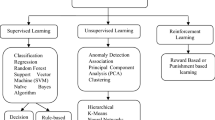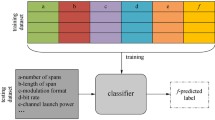Abstract
Introducing a novel approach for assessing connectivity in dynamic optical networks, we propose the quantum-driven particle swarm-optimized self-adaptive support vector machine (QPSO-SASVM) model. By integrating quantum computing and machine learning, this advanced framework offers enhanced convergence and robustness. Tested against a network simulation with 187 nodes and 96 DWDM channels, QPSO-SASVM outperforms traditional benchmarks such as LSTM, Naive method, E-DLSTM, and GRU. Evaluation using metrics such as signal-to-noise ratio, ROC curve, RMSE, and R2 consistently demonstrates superior predictive accuracy and adaptability. These results underscore QPSO-SASVM as a powerful tool for precise and reliable prediction in dynamic optical network environments.










Similar content being viewed by others
Explore related subjects
Discover the latest articles and news from researchers in related subjects, suggested using machine learning.Data availability
No datasets were generated or analyzed during the current study.
References
Rose J, Odu A, Adedokun D (2023) Optimizing deployment strategies for targeted network performance in multilayer Pb/s networks. https://doi.org/10.31219/osf.io/7zdvw
Uzunidis D, Logothetis M, Stavdas A, Hillerkuss D, Tomkos I (2022) Fifty years of fixed optical networks evolution: a survey of architectural and technological developments in a layered approach. Telecom 3(4):619–674. https://doi.org/10.3390/telecom3040035
Singh H, Ramya D, Saravanakumar R, Sateesh N, Anand R, Singh S, Neelakandan S (2022) Artificial intelligence based quality of transmission predictive model for cognitive optical networks. Optik 257:168789. https://doi.org/10.1016/j.ijleo.2022.168789
Liu X, Deng N (2020) Emerging optical communication technologies for 5G. Optical fiber telecommunications VII. Academic Press, Cambridge, pp 751–783. https://doi.org/10.1016/B978-0-12-816502-7.00019-1
Behnke I, Austad H (2023) Real-time performance of industrial IoT communication technologies: a review. IEEE Internet Things J. https://doi.org/10.1109/JIOT.2023.3332507
Chowdhury MZ, Hasan MK, Shahjalal M, Hossan MT, Jang YM (2020) Optical wireless hybrid networks: trends, opportunities, challenges, and research directions. IEEE Commun Surv Tutor 22(2):930–966. https://doi.org/10.1109/COMST.2020.2966855
AbdulNabi MA, Saad WK, Hamza BJ (2021) Designing and improving NG-PON2-RoF with inelastic scattering and nonlinear impairments by signal processing techniques. In next generation of internet of things: proceedings of ICNGIoT 2021, Springer, Singapore. pp 369–384. https://doi.org/10.1007/978-981-16-0666-3_29
Ahmad T, Zhang D (2021) Using the internet of things in smart energy systems and networks. Sustain Cities Soc 68:102783. https://doi.org/10.1016/j.scs.2021.102783
Moreno-Marcos PM, Pong TC, Muñoz-Merino PJ, Kloos CD (2020) Analysis of the factors influencing learners' performance prediction with learning analytics. IEEE Access 8:5264–5282. https://doi.org/10.1109/ACCESS.2019.2963503
Kougioumtzidis G, Poulkov V, Zaharis ZD, Lazaridis PI (2022) A survey on multimedia services QoE assessment and machine learning-based prediction. IEEE Access 10:19507–19538. https://doi.org/10.1109/ACCESS.2022.3149592
Cruzes S (2023) Optical networks automation overview: a survey. Authorea Preprints. https://doi.org/10.36227/techrxiv.24310666.v1
Hassija V, Chamola V, Mahapatra A, Singal A, Goel D, Huang K, Scardapane S, Spinelli I, Mahmud M, Hussain A (2023) Interpreting black-box models: a review on explainable artificial intelligence. Cogn Comput 16(1):1–30. https://doi.org/10.1007/s12559-023-10179-8
Zhang L, Li X, Tang Y, Xin J, Huang S (2022) A survey on QoT prediction using machine learning in optical networks. Opt Fiber Technol 68:102804. https://doi.org/10.1016/j.yofte.2021.102804
Karim FK, Khafaga DS, Eid MM, Towfek SK, Alkahtani HK (2023) A novel bio-inspired optimization algorithm design for wind power engineering applications time-series forecasting. Biomimetics 8(3):321. https://doi.org/10.3390/biomimetics8030321
Gu R, Yang Z, Ji Y (2020) Machine learning for intelligent optical networks: a comprehensive survey. J Netw Comput Appl 157:102576. https://doi.org/10.1016/j.jnca.2020.102576
Saif WS, Ragheb AM, Alshawi TA, Alshebeili SA (2020) Optical performance monitoring in mode division multiplexed optical networks. J Lightwave Technol 39(2):491–504. https://doi.org/10.1109/JLT.2020.3027725
Liu X, Lun H, Fu M, Fan Y, Yi L, Hu W, Zhuge Q (2020) AI-based modeling and monitoring techniques for future intelligent elastic optical networks. Appl Sci 10(1):363. https://doi.org/10.3390/app10010363
Ji Y, Gu R, Yang Z, Li J, Li H, Zhang M (2020) Artificial intelligence-driven autonomous optical networks: 3S architecture and key technologies. Sci China Inf Sci 63:1–24. https://doi.org/10.1007/s11432-020-2871-2
Allogba S, Aladin S, Tremblay C (2021) Multivariate machine learning models for short-term forecast of lightpath performance. J Lightwave Technol 39(22):7146–7158. https://doi.org/10.1109/JLT.2021.3110513
Khan FN, Fan Q, Lau APT, Lu C (2020) Applications of machine-learning in optical communications and networks. In next-generation optical communication: components, sub-systems, and systems IX, vol 11309, pp 83–90. SPIE, 2020. SPIE. https://doi.org/10.1117/12.2544102
Yousefi S, Chouman H, Djukic P, Golaghazadeh F, Tremblay C, Desrosiers C (2023) Forecasting lightpath quality of transmission and implementing uncertainty in the forecast models. J Lightwave Technol. https://doi.org/10.1109/JLT.2023.3252441
Mohammed Salim ON, Adnan SA, Mutlag AH (2023) Artificial neural network-based transmission power control for underwater wireless optical communication system. Eng Technol J 41(2):456–466. https://doi.org/10.30684/etj.2022.136247.1309
Shao R, Ding C, Liu L, He Q, Qu Y, Yang J (2024) High-fidelity multi-channel optical information transmission through scattering media. Opt Express 32(2):2846–2855. https://doi.org/10.1364/OE.514668
Pointurier Y (2021) Machine learning techniques for quality of transmission estimation in optical networks. J Opt Commun Netw 13(4):B60–B71. https://doi.org/10.1364/JOCN.417434
D'Amico A, London E, Virgillito E, Napoli A, Curri, V (2020) Quality of transmission estimation for planning of disaggregated optical networks. In 2020 International Conference on Optical Network Design and Modeling (ONDM), IEEE. May 2020, pp 1–3. https://doi.org/10.23919/ONDM48393.2020.9133012
Rottondi C, di Marino R, Nava M, Giusti A, Bianco A (2021) On the benefits of domain adaptation techniques for quality of transmission estimation in optical networks. J Opt Commun Netw 13(1):A34–A43. https://doi.org/10.1364/JOCN.401915
Azzimonti D, Rottondi C, Tornatore M (2020) Reducing probes for quality of transmission estimation in optical networks with active learning. J Opt Commun Netw 12(1):A38–A48. https://doi.org/10.1364/JOCN.12.000A38
Mahajan A, Christodoulopoulos KK, MartÃnez R, Muñoz R, Spadaro S (2021) Quality of transmission estimator retraining for dynamic optimization in optical networks. J Opt Commun Netw 13(4):B45–B59. https://doi.org/10.1364/JOCN.411524
Kozdrowski S, Cichosz P, Paziewski P, Sujecki S (2020) Machine learning algorithms for prediction of the quality of transmission in optical networks. Entropy 23(1):7. https://doi.org/10.3390/e23010007
Aladin S, Tran AVS, Allogba S, Tremblay C (2020) Quality of transmission estimation and short-term performance forecast of lightpaths. J Lightwave Technol 38(10):2807–2814. https://doi.org/10.1109/JLT.2020.2975179
Funding
No funding has been received to carry out the work.
Author information
Authors and Affiliations
Contributions
Mehaboob Mujawar helped in revision work. S.Manikandan was a paper writer. Monica Kalbande worked in research problem and objectives. Puneet Kumar Aggarwal helped in the research design, selecting methods, and collecting and analyzing data. Nallam Krishnaiah was responsible for writing the initial manuscript, including introduction, methods, and results sects. Yasin Genc supervised the research and ensured the overall success of the project.
Corresponding author
Ethics declarations
Conflict of interest
The authors declare no competing interests.
Additional information
Publisher's Note
Springer Nature remains neutral with regard to jurisdictional claims in published maps and institutional affiliations.
Rights and permissions
Springer Nature or its licensor (e.g. a society or other partner) holds exclusive rights to this article under a publishing agreement with the author(s) or other rightsholder(s); author self-archiving of the accepted manuscript version of this article is solely governed by the terms of such publishing agreement and applicable law.
About this article
Cite this article
Mujawar, M., Manikandan, S., Kalbande, M. et al. Optimizing connectivity: a novel AI approach to assess transmission levels in optical networks. J Supercomput 80, 26568–26588 (2024). https://doi.org/10.1007/s11227-024-06410-4
Accepted:
Published:
Issue Date:
DOI: https://doi.org/10.1007/s11227-024-06410-4




